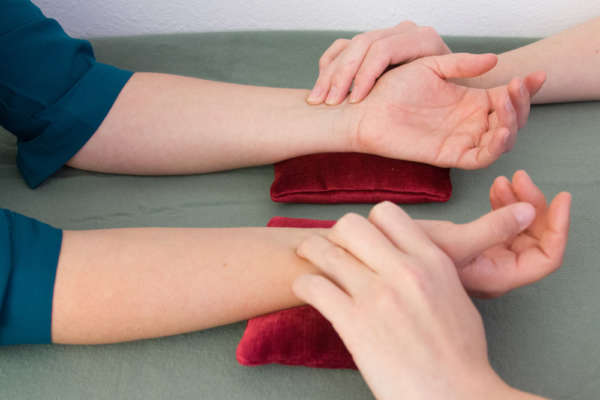
When you go to see your doctor, they will almost always check your heart rate, blood pressure, temperature, weight and oxygenation level. When you walk into the office of an East Asian Medical doctor, you might notice that things are a little different. East Asian Medicine uses tongue and pulse diagnosis, coupled with your symptomology, to arrive at a diagnosis that then allows for proper treatment techniques. This can seem strange to many people, but it is quite effective. Tongue diagnosis was covered in a previous post, so now it’s time to talk about your pulse.
First off, the pulse is measured at three levels and three positions on each arm. The positions on each wrist correspond to different organs and meridians in the body. In addition to position, we take note of the pulse on each level, meaning the pulse on a superficial level, where we press lightly against the wrist, to the deep level where we will press firmly against the wrist. This also can speak to the overall health of the organs, meridian and the vital energy (qi) of the body.
Each pulse position – called cun, guan, and chi in Chinese – may have a different depths and qualities. Certain factors influence the pulse. The strength and quality of the pulse tends to decline as a person ages. Men generally have a stronger pulse on the left side and women are generally stronger on the right. Also the change of seasons can influence the pulse, which tend to be deeper in the winter and stronger in the summer.
There are many types of pulses in East Asian Medicine. Each kind of pulse can help diagnose a condition. For instance, if a pulse feels empty at any position, it can indicate a lack of qi or blood in the body. This is commonly seen in people with fatigue and general weakness. An empty pulse is wide but not strong and will disappear with even slight pressure. In contrast, a full pulse in any position can indicate energy (qi) that is stuck or pooling in the body. Or it can also be caused by other excesses such as heat or blood stasis. A full pulse is wide and strong and is felt with strength at all levels. Another common pulse seen in the clinic is a wiry pulse. A wiry pulse is tense and thin, like a guitar string. This pulse is common in conditions affected by stress. There is also a slippery pulse. A slippery pulse has a smooth fluid like layer over the pulse which indicates excess fluid in the body, digestive issues and can also be commonly felt in pregnant women.
Try feeling your own pulse by placing your index finger just below the crease of your wrist and your middle and ring fingers in line behind it. Apply a light pressure with these three fingers and describe how your radial artery feels. It might surprise you that the left side is different from the right side. However, this is quite common and provides further insight into what is ailing each patient.
Pulse diagnosis isn’t perfect and generally takes years to master. Extraneous factors like how long ago you ate can influence it and it’s been said that if a person were to have eight masters check his or her pulse, each one may read it differently. While some practitioners base their treatments on the pulse alone, I use it as another tool in the tool box to confirm what is already suspected. This allows for a more thorough diagnosis and treatment protocol that can help you recover and heal.

